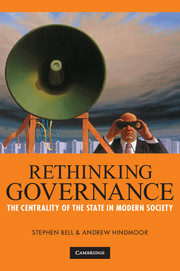Book contents
- Frontmatter
- Contents
- Figures and tables
- Preface
- 1 A state-centric relational approach
- 2 The resilient state
- 3 Metagovernance and state capacity
- 4 Hierarchy and top-down governance
- 5 Governance through persuasion
- 6 Governance through markets and contracts
- 7 Governance through community engagement
- 8 Governance through associations
- 9 Conclusion
- Notes
- Bibliography
- Index
4 - Hierarchy and top-down governance
Published online by Cambridge University Press: 05 June 2012
- Frontmatter
- Contents
- Figures and tables
- Preface
- 1 A state-centric relational approach
- 2 The resilient state
- 3 Metagovernance and state capacity
- 4 Hierarchy and top-down governance
- 5 Governance through persuasion
- 6 Governance through markets and contracts
- 7 Governance through community engagement
- 8 Governance through associations
- 9 Conclusion
- Notes
- Bibliography
- Index
Summary
Governance refers to the tools, strategies and relationships used by governments to help govern. Hierarchical governance is distinguished by the direct application of state authority to target populations. It arises when states impose rules or standards of behaviour on other actors, backed by sanctions and rewards, in order to achieve collective goals. The claim that there has been a ‘fundamental transformation’ in the ‘basic forms’ of governance (Salamon, 2002, 1–2) can be understood as saying that governance through hierarchy is being gradually superseded by governance through markets, associations and community engagement. We believe that this society-centric argument is misleading; that the state is far from being passé and that we still need to recognise the ‘distinctiveness or uniqueness of state action within contemporary governance’ (Crawford, 2006, 458). The actors who control the modern state have at their disposal a set of powers and resources – from formal constitutional and legal authority to vast fiscal, administrative, informational resources and access to expertise – that are qualitatively and quantitatively unlike those available to other actors in society. These resources are frequently employed to govern hierarchically.
In later chapters we pursue our argument that states can enhance their capacity by developing close relations with a wide variety of non-state actors. This chapter argues that the extent to which governance through markets, associations or communities has replaced hierarchical governance has been exaggerated. Hierarchy is not simply holding its own against other governance mechanisms: in some cases it is resurgent.
- Type
- Chapter
- Information
- Rethinking GovernanceThe Centrality of the State in Modern Society, pp. 71 - 96Publisher: Cambridge University PressPrint publication year: 2009



